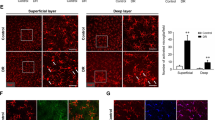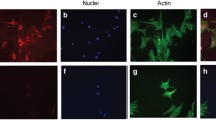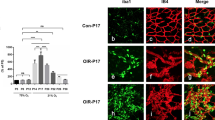Abstract
Purpose
Pericyte apoptosis is a predominant feature of early diabetic retinopathy. In diabetic retinopathy, activated microglia migrate and release proinflammatory cytokines that contribute to disruption of the blood–retinal barrier, neuronal loss, and enhanced ROS production. Reactive oxygen species (ROS) are implicated in pericyte death; however, the mechanism by which activated microglia affect retinal microvascular pericytes is unclear. We hypothesized that activated microglia may promote pericyte apoptosis by enhancing ROS production.
Methods
Lipopolysaccharide (LPS)-activated microglia and pericytes were co-cultured in a cell culture system. Pericyte ROS production and the mitochondrial membrane potential (ΔΨm) were determined by flow cytometry. The pericyte protein expression levels of NADPH oxidase subunits, uncoupling protein 2, nuclear NF-κB-p65, and caspase-3 were determined by western blotting. One-way ANOVAs were used for statistical analysis.
Results
LPS successfully activated the microglia, as demonstrated by their morphological and phenotype changes and the significant increase in tumor necrosis factor secretion (P < 0.01). Co-culture with activated microglia significantly up-regulated NADPH oxidase subunits (NOX4, NOX2, and NCF1; P < 0.01) and down-regulated uncoupling protein 2 expression (P < 0.01) in pericytes. Pericyte ROS production increased by 20% in the activated microglia co-cultured group, and was inhibited by pretreatment with diphenyleneiodonium, coenzyme Q10, and N-acetylcysteine. The proapoptotic pericyte changes induced by co-culture with activated microglia included a 9.50% decrease in pericyte ΔΨm and significant increases in NF-κB-p65 nuclear translocation (P < 0.01) and activated caspase-3 (P < 0.01). These proapoptotic effects of activated microglia were inhibited by diphenyleneiodonium.
Conclusions
Our results are consistent with our hypothesis that activated microglia may promote pericyte apoptosis by enhancing ROS production. Further studies are needed to examine retinal microglia activation and the corresponding changes in pericytes in a rat model of diabetes mellitus.








Similar content being viewed by others
References
Crawford TN, Alfaro DV III, Kerrison JB, Jablon EP (2009) Diabetic retinopathy and angiogenesis. Curr Diabetes Rev 5:8–13
Sims DE (1986) The pericyte—a review. Tissue Cell 18:153–174
Motiejunaite R, Kazlauskas A (2008) Pericytes and ocular diseases. Exp Eye Res 86:171–177
Antonelli-Orlidge A, Saunders KB, Smith SR, D’Amore PA (1989) An activated form of transforming growth factor β is produced by cocultures of endothelial cells and pericytes. Proc Natl Acad Sci U S A 86:4544–4548
Willard AL, Herman IM (2012) Vascular complications and diabetes: current therapies and future challenges. J Ophthalmol :209538
Armulik A, Genove G, Betsholtz C (2011) Pericytes: developmental, physiological, and pathological perspectives, problems, and promises. Dev Cell 21:193–215
Hirschi KK, D’Amore PA (1997) Control of angiogenesis by the pericyte: molecular mechanisms and significance. EXS 79:419–428
Pfister F, Feng Y, vom Hagen F, Hoffmann S, Molema G, Hillebrands JL, Shani M, Deutsch U, Hammes HP (2008) Pericyte migration: a novel mechanism of pericyte loss in experimental diabetic retinopathy. Diabetes 57:2495–2502
Li W, Yanoff M, Liu X, Ye X (1997) Retinal capillary pericyte apoptosis in early human diabetic retinopathy. Chin Med J (Engl) 110:659–663
Liu B, Bhat M, Padival AK, Smith DG, Nagaraj RH (2004) Effect of dicarbonyl modification of fibronectin on retinal capillary pericytes. Invest Ophthalmol Vis Sci 45:1983–1995
Denis U, Lecomte M, Paget C, Ruggiero D, Wiernsperger N, Lagarde M (2002) Advanced glycation end-products induce apoptosis of bovine retinal pericytes in culture: involvement of diacylglycerol/ceramide production and oxidative stress induction. Free Radic Biol Med 33:236–247
Pomero F, Allione A, Beltramo E, Buttiglieri S, D’Alù F, Ponte E, Lacaria A, Porta M (2003) Effects of protein kinase C inhibition and activation on proliferation and apoptosis of bovine retinal pericytes. Diabetologia 46:416–419
Kim J, Kim KM, Kim CS, Sohn E, Lee YM, Jo K, Kim JS (2012) Puerarin inhibits the retinal pericyte apoptosis induced by advanced glycation end products in vitro and in vivo by inhibiting NADPH oxidase-related oxidative stress. Free Radic Biol Med 53:357–365
Rees MD, Kennett EC, Whitelock JM, Davies MJ (2008) Oxidative damage to extracellular matrix and its role in human pathologies. Free Radic Biol Med 44:1973–2001
Forbes JM, Coughlan MT, Cooper ME (2008) Oxidative stress as a major culprit in kidney disease in diabetes. Diabetes 57:1446–1454
Grigsby JG, Cardona SM, Pouw CE, Muniz A, Mendiola AS, Tsin AT, Allen DM, Cardona AE (2014) The role of microglia in diabetic retinopathy. J Ophthalmol 2014:705783
Adamis AP, Berman AJ (2008) Immunological mechanisms in the pathogenesis of diabetic retinopathy. Semin Immunopathol 30:65–84
Rungger-Brandle E, Dosso AA, Leuenberger PM (2000) Glial reactivity, an early feature of diabetic retinopathy. Invest Ophthalmol Vis Sci 41:1971–1980
Zeng XX, Ng YK, Ling EA (2000) Neuronal and microglial response in the retina of streptozotocin-induced diabetic rats. Vis Neurosci 17:463–471
Krady JK, Basu A, Allen CM, Xu Y, LaNoue KF, Gardner TW, Levison SW (2005) Minocycline reduces proinflammatory cytokine expression, microglial activation, and caspase-3 activation in a rodent model of diabetic retinopathy. Diabetes 54:1559–1565
Zeng HY, Green WR, Tso MO (2008) Microglial activation in human diabetic retinopathy. Arch Ophthalmol 126:227–232
Capetandes A, Gerritsen ME (1990) Simplified methods for consistent and selective culture of bovine retinal endothelial cells and pericytes. Invest Ophthalmol Vis Sci 31:1738–1744
Dijkstra CD, Döpp EA, Joling P, Kraal G (1985) The heterogeneity of mononuclear phagocytes in lymphoid organs: distinct macrophage subpopulations in the rat recognized by monoclonal antibodies ED1, ED2 and ED3. Immunology 54:589–599
Magnus T, Chan A, Linker RA, Toyka KV, Gold R (2002) Astrocytes are less efficient in the removal of apoptotic lymphocytes than microglia cells: implications for the role of glial cells in the inflamed central nervous system. J Neuropathol Exp Neurol 61:760–766
Wang AL, Yu AC, He QH, Zhu X, Tso MO (2007) AGEs mediated expression and secretion of TNF alpha in rat retinal microglia. Exp Eye Res 84:905–913
Zeng HY, Tso MO, Lai S, Lai H (2008) Activation of nuclear factor-κB during retinal degeneration in rd mice. Mol Vis 14:1075–1080
Rahman N, Dhadi SR, Deshpande A, Ramakrishna W (2016) Rice callus suspension culture inhibits growth of cell lines of multiple cancer types and induces apoptosis in lung cancer cell line. BMC Complement Altern Med 16:427
Johnsen AR, Bendixen K, Karlson U (2002) Detection of microbial growth on polycyclic aromatic hydrocarbons in microtiter plates by using the respiration indicator WST-1. Appl Environ Microbiol 68:2683–2689
Baker MA, Krutskikh A, Curry BJ, McLaughlin EA, Aitken RJ (2004) Identification lucigenin and tetrazolium salt reduction in rat epididymal sperm preparations. Biol Reprod 71:307–318
Rosen P, Nawroth PP, King G, Möller W, Tritschler HJ, Packer L (2001) The role of oxidative stress in the onset and progression of diabetes and its complications: a summary of a Congress Series sponsored by UNESCO-MCBN, the American Diabetes Association and the German Diabetes Society. Diabetes Metab Res Rev 17:189–212
Lum H, Malik AB (1994) Regulation of vascular endothelial barrier function. Am J Physiol 267:L223–L241
Roberge S, Roussel J, Andersson DC, Meli AC, Vidal B, Blandel F, Lanner JT, Le Guennec JY, Katz A, Westerblad H, Lacampagne A, Fauconnier J (2014) TNF-alpha-mediated caspase-8 activation induces ROS production and TRPM2 activation in adult ventricular myocytes. Cardiovasc Res 103:90–99
Shiraki A, Oyama J, Komoda H, Asaka M, Komatsu A, Sakuma M, Kodama K, Sakamoto Y, Kotooka N, Hirase T, Node K (2012) The glucagon-like peptide 1 analog liraglutide reduces TNF-alpha-induced oxidative stress and inflammation in endothelial cells. Atherosclerosis 221:375–382
Rochfort KD, Collins LE, McLoughlin A, Cummins PM (2015) TNF-alpha-mediated disruption of cerebrovascular endothelial barrier integrity in vitro involves the production of proinflammatory IL-6. J Neurochem 136:564–572
Rousset F, Hazane-Puch F, Pinosa C, Nguyen MV, Grange L, Soldini A, Rubens-Duval B, Dupuy C, Morel F, Lardy B (2015) IL-1beta mediates MMP secretion and IL-1beta neosynthesis via upregulation of p22(phox) and NOX4 activity in human articular chondrocytes. Osteoarthr Cartil 23:1972–1980
Groemping Y, Lapouge K, Smerdon SJ, Rittinger K (2003) Molecular basis of phosphorylation-induced activation of the NADPH oxidase. Cell 113:343–355
Wu H, Jiang C, Gan D, Liao Y, Ren H, Sun Z, Zhang M, Xu G (2011) Different effects of low- and high-dose insulin on ROS production and VEGF expression in bovine retinal microvascular endothelial cells in the presence of high glucose. Graefes Arch Clin Exp Ophthalmol 249:1303–1310
Ago T, Kitazono T, Kuroda J, Kumai Y, Kamouchi M, Ooboshi H, Wakisaka M, Kawahara T, Rokutan K, Ibayashi S, Iida M (2005) NAD(P)H oxidases in rat basilar arterial endothelial cells. Stroke 36:1040–1046
Ago T, Kitazono T, Ooboshi H, Iyama T, Han YH, Takada J, Wakisaka M, Ibayashi S, Utsumi H, Iida M (2004) Nox4 as the major catalytic component of an endothelial NAD(P)H oxidase. Circulation 109:227–233
Kuroda J, Nakagawa K, Yamasaki T, Nakamura K, Takeya R, Kuribayashi F, Imajoh-Ohmi S, Igarashi K, Shibata Y, Sueishi K, Sumimoto H (2005) The superoxide-producing NAD(P)H oxidase Nox4 in the nucleus of human vascular endothelial cells. Genes Cells 10:1139–1151
Kuroda J, Ago T, Nishimura A, Nakamura K, Matsuo R, Wakisaka Y, Kamouchi M, Kitazono T (2014) Nox4 is a major source of superoxide production in human brain pericytes. J Vasc Res 51:429–438
Su WP, Lo YC, Yan JJ, Liao IC, Tsai PJ, Wang HC, Yeh HH, Lin CC, Chen HH, Lai WW, Su WC (2012) Mitochondrial uncoupling protein 2 regulates the effects of paclitaxel on Stat3 activation and cellular survival in lung cancer cells. Carcinogenesis 33:2065–2075
Purcell NH, Tang G, Yu C, Mercurio F, DiDonato JA, Lin A (2001) Activation of NF-κB is required for hypertrophic growth of primary rat neonatal ventricular cardiomyocytes. Proc Natl Acad Sci U S A 98:6668–6673
Higuchi Y, Otsu K, Nishida K, Hirotani S, Nakayama H, Yamaguchi O, Matsumura Y, Ueno H, Tada M, Hori M (2002) Involvement of reactive oxygen species-mediated NF-κB activation in TNF-α-induced cardiomyocyte hypertrophy. J Mol Cell Cardiol 34:233–240
Romeo G, Liu WH, Asnaghi V, Kern TS, Lorenzi M (2002) Activation of nuclear factor-κB induced by diabetes and high glucose regulates a proapoptotic program in retinal pericytes. Diabetes 51:2241–2248
Bagul PK, Deepthi N, Sultana R, Banerjee SK (2015) Resveratrol ameliorates cardiac oxidative stress in diabetes through deacetylation of NFκB-p65 and histone 3. J Nutr Biochem. doi:10.1016/j.jnutbio.2015.06.006
Huang H, Gandhi JK, Zhong X, Wei Y, Gong J, Duh EJ, Vinores SA (2011) TNF alpha is required for late BRB breakdown in diabetic retinopathy, and its inhibition prevents leukostasis and protects vessels and neurons from apoptosis. Invest Ophthalmol Vis Sci 52:1336–1344
Acknowledgements
Haixiang Wu conceived and designed the experiments; Xinyi Ding performed the experiments with the assistance of Meng Zhang and Ruiping Gu. Xinyi Ding analyzed the data and prepared the manuscript. Haixiang Wu is the guarantor of this study and, as such, had full access to all the data used, and takes responsibility for the integrity of the data and the accuracy of the analyses.
Author information
Authors and Affiliations
Corresponding author
Ethics declarations
Funding
This work was supported by funding from the National Natural Science Foundation for Young Scholars of China (nos. 81300781 and 81400410). The funder had no role in study design, data collection and analysis, decision to publish, or preparation of the manuscript.
Conflict of interest
All authors certify that they have no affiliations with or involvement in any organization or entity with any financial interest (such as honoraria; educational grants; participation in speakers’ bureaus; membership, employment, consultancies, stock ownership, or other equity interest; and expert testimony or patent-licensing arrangements) or non-financial interest (such as personal or professional relationships, affiliations, knowledge or beliefs) in the subject matter or materials discussed in this manuscript.
Ethical approval
All applicable international, national, and/or institutional guidelines for the care and use of animals were followed.
Rights and permissions
About this article
Cite this article
Ding, X., Zhang, M., Gu, R. et al. Activated microglia induce the production of reactive oxygen species and promote apoptosis of co-cultured retinal microvascular pericytes. Graefes Arch Clin Exp Ophthalmol 255, 777–788 (2017). https://doi.org/10.1007/s00417-016-3578-5
Received:
Revised:
Accepted:
Published:
Issue Date:
DOI: https://doi.org/10.1007/s00417-016-3578-5




